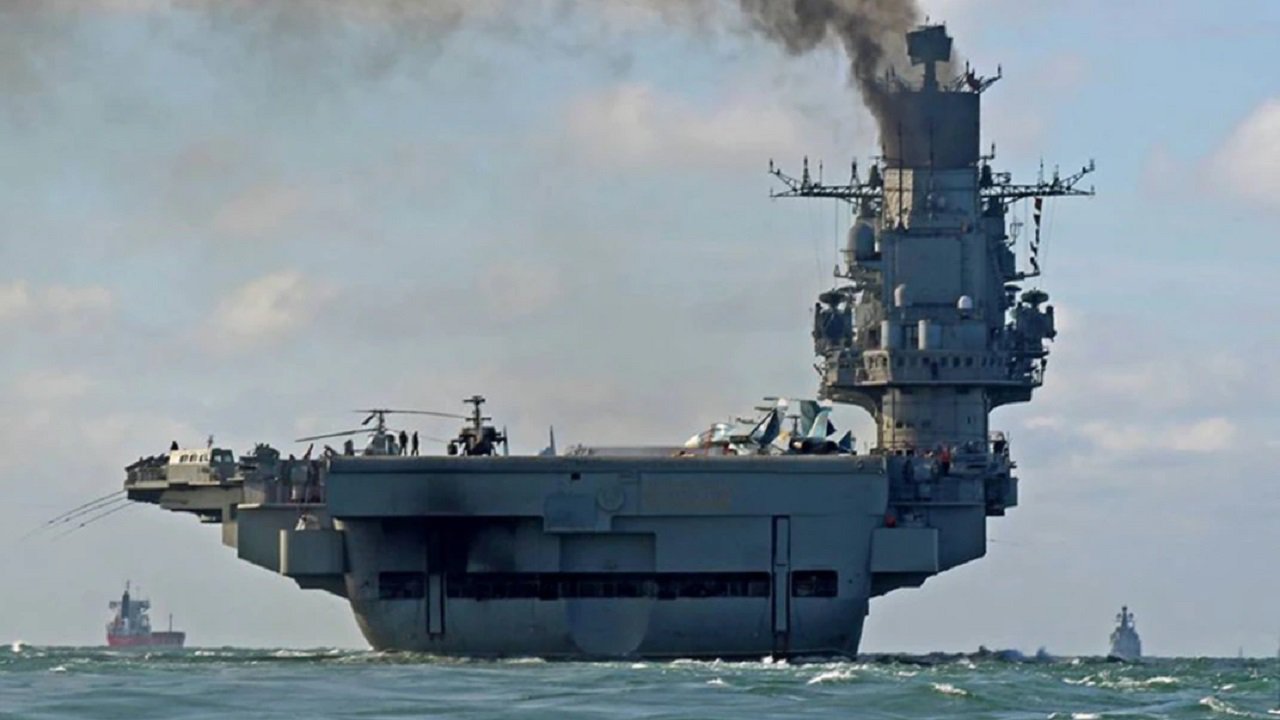Could Russia Actually Be Planning a New Aircraft Carrier? – Currently, the Russian Navy has no aircraft carriers in active service. Its sole flattop, the Admiral Flota Sovetskogo Soyuza Kuznetsov, has been in drydock undergoing a refit since early 2018 and the current projection is that repairs will be completed sometime next year. However, it was just weeks ago that the problem-plagued warship faced its latest setback when it caught fire. Though no one was injured, it is at least the second fire and most recent accident to impact the still ongoing repair efforts.
(Subscribe to Our YouTube Channel Here. 19FortyFive publishes original videos every day.)
The latest mishap came as the carrier was set to leave its specially-built drydock at the 35th Ship Repair Plant in Murmansk, Russia. Until the work is completed, the Russian Navy remains without its flagship and has no operational aircraft carrier.
That actually doesn’t mean much for the Kremlin, which is focused on a ground war in Ukraine, but some in Russia still see a need for such a warship.
A New Russian Aircraft Carrier?
The CEO of Russia’s United Shipbuilding Corporation (USC) suggested that the firm could be developing a design for a new and modern class of aircraft carrier for the Russian Navy.
According to a report from Tass on Monday, Alexey Rakhmanov, the head of USC, said that considerations should be made on whether the Russian Navy should operate such vessels and what capabilities the carrier could possess.
“This is a question for the Navy,” Rakhmanov said in an interview that was published on the USC website, adding, “Whether an aircraft carrier should or should not be built, and what kind of carrier. This discussion has been going on for as long as I have worked in the company, for 8 years now. We are proactive in design, and we regularly convey our position to the Navy. We have to know, and know precisely, what our enemy thinks and what it does.”
The USC CEO further underscored that the corporation has its own opinion on “what a future aircraft carrier is, how it should be built, and with what technological specifications.”
Does Russia Need an Aircraft Carrier?
The question, of course, is whether Moscow actually has any need for such an aircraft carrier– other than the fact that emerging powers, including China and India, now operate multiple flattops. Aircraft carriers are still seen as any naval power’s most valuable sea-based asset, and while they are expensive to build and maintain, they still provide a unique capability to project air power over a wide area.
Yet, Russia has never had much luck with the warships. Even in the Soviet era, its aircraft cruisers largely lacked the range and endurance of the U.S. Navy’s conventional powered carriers – and were considered vastly inferior to the larger nuclear-powered supercarriers.
The Soviet Navy operated a number of helicopter carriers during the Cold War, and later operated four Kiev-class aircraft cruisers, two of which were sold to China and converted into a theme park/hotel and museum piece, while a third was scrapped. The fourth – a modified Kiev-class – was modified, rebuilt, and sold to India and recommissioned as the INS Vikramaditya.
The supercarrier Ulyanovsk was under construction as well but was scrapped following the dissolution of the Soviet Union.
A Chinese Buyback?
The sister ship of Admiral Kuznetsov – the former Varyag – was also under construction when the Soviet Union collapsed and was sold by Ukraine to China. It is now in service with China’s People’s Liberation Army Navy (PLAN) as the Type 001 Liaoning.
However, earlier this month, Sergey Karginov, the first deputy chairman of the Committee of the State Duma of the Federal Assembly of the Russian Federation on Development of Far East and Arctic, proposed that Moscow should seek to buy back the carrier for service in the Black Sea.
Such a plan isn’t likely to get very far, and it is unlikely Beijing would be open to such a proposal. As a result, Admiral Kuznetsov will likely remain Russia’s sole carrier – at least until a new vessel could be built.
Focus on Admiral Kuznetsov
The focus still remains on Admiral Kuznetsov, and Rakhmanov said in that recent interview that the heavy aircraft cruiser is on track to be recommissioned next year, while more than 2,000 people are currently involved in her refit.
“Repairs did not stop for even a single minute of the cruiser’s time in the dock,” he noted.
Of course, Rakhmanov didn’t mention the multiple fires, the crane that crashed onto the flight deck, or the problems with corruption at the shipyard. All of those issues have been serious enough that some observers continue to question if – not when – Admiral Kuznetsov will actually return to service. That is even before we can seriously believe USC is actually capable of building a brand new carrier when it continues to show that it isn’t even able to complete a refit.
Author Experience and Expertise: A Senior Editor for 19FortyFive, Peter Suciu is a Michigan-based writer. He has contributed to more than four dozen magazines, newspapers, and websites with over 3,200 published pieces over a twenty-year career in journalism. He regularly writes about military hardware, firearms history, cybersecurity, politics, and international affairs. Peter is also a Contributing Writer for Forbes and Clearance Jobs. You can follow him on Twitter: @PeterSuciu.

